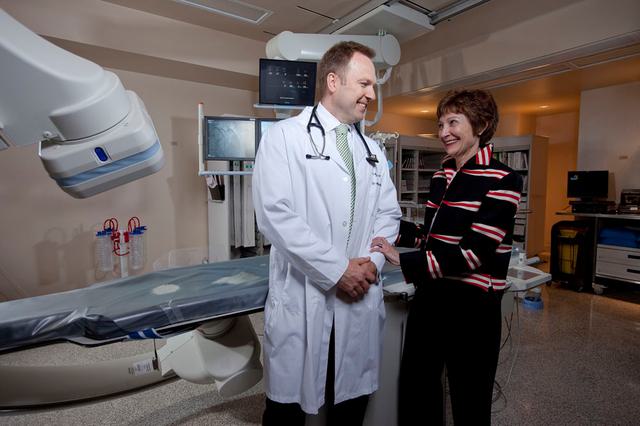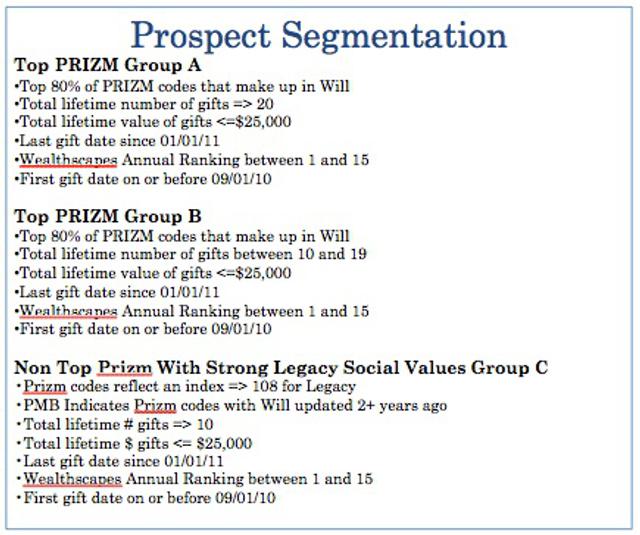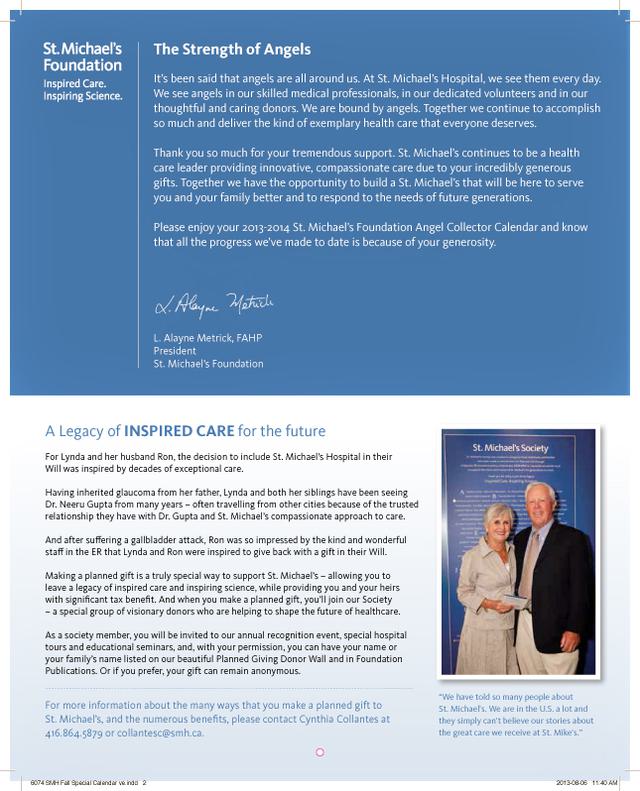St Michael’s Hospital Foundation: data-based planned giving campaign delivers heavenly results
- Exhibited by
- Dwayne DiPasquale, director annual giving, St. Michael's Foundation.
- Added
- August 13, 2013
- Medium of Communication
- Direct mail
- Target Audience
- Individuals
- Type of Charity
- Healthcare
- Country of Origin
- Canada
- Date of first appearance
- December, 2012
SOFII’s view
To be good fundraisers we all want to help our donors to give to our urgent causes in the way that they want to. But without knowing who are donors are we won’t be able to do that. St Michael’s Hospital Foundation carried out an incredibly detailed analysis and profiling exercise to build stronger lists that enabled them to make more personalised phone calls to their donors. And achieved some excellent results.
Any takers on a vote to find out which is the most popular category? SOFII quite fancies being a cosmopolitan elite, but a young digerati would be close.
Creator / originator
Dwayne DiPasquale and Cynthia Collantes, St Michael’s Hospital Foundation.
Summary / objectives
To improve overall conversion and response rates for our recent planned giving/legacy leader campaign using data-based segmentation with traditional methodology to create an innovation programme to reach out to the Foundation’s stakeholders.
Background
For St Michael’s Hospital Foundation, which supports the Catholic hospital founded in 1892 by the Sisters of St Joseph, every fundraising campaign is considered critical to providing care for the sick and poor of Toronto’s inner city. Over the last century, St. Michael’s has evolved into a major teaching and research hospital affiliated with the University of Toronto and offering more than 450 inpatient beds, extensive outpatient programmes and a downtown Toronto trauma centre.
The Foundation uses a number of strategies to ensure the hospital can continue to serve the patients and their families that rely on St Michael’s for their health care each and every day. Traditionally, the Foundation’s planned giving programme would focus on its regular donors – a group known as the Friends of St Michael’s Hospital– and appeal to members’ desire to leave a lasting legacy to the hospital.
Using a two-part approach, fundraisers first sent prospective planned giving donors letters featuring an existing planned giving donor encouraging others to consider making a bequest. Then a trained telemarketer followed-up with a call to secure their intention to make the gift. In fact, this approach had been working well. In the last few campaigns, we were getting a 22 percent conversion rate from those indicating a willingness to make a bequest. But like many not-for-profits with so much at stake, St Michael’s Foundation wanted to do better. Last autumn, our planned giving officer, Cynthia Collantes, teamed up with our annual giving programme director, Dwayne DiPasquale, and using data-based segmentation with traditional methodology we created an innovation programme to reach out to our donors.
The big question was one faced by all fundraisers: are we marrying the needs of the donor with the needs of the hospital and Foundation in order to achieve a common goal? To conduct the analysis, we turned to the PRIZMC2 segmentation system from Environics Analytics (EA). We first profiled existing planned givers by the traditional marketing metrics of recency, frequency and the monetary value of their gifts. And our findings were most revealing. The data showed that the previous campaigns were not approaching prospects who had the greatest likelihood of donating legacy gifts. For instance, typical planned givers will make 27 gifts over the course of their lives. Yet we were reaching out to donors who gave an average of 35 gifts in their lifetime. That told us that we were targeting donors who had given more than a typical planned gift donor and may be conditioned to give only through annual donations rather than through a planned gift. Our goal was to find prospects who mirrored existing bequest donors. We found we had a gap between who we were mailing to and who our best planned giving prospects were.
Next, we overlaid EA’s WealthScapes financial data onto our overall current donor file and created a predictive model that scored donors from one to 20 – with one being the best – on their likelihood to make a mid-level annual gift of $5,000 to $15,000. We then analysed our current planned giving donors as well as our previous prospect lists based on their predictive score.
The good news is that one-third of our current bequest donors had WealthScapes scores of one to five, which was a little surprising for us considering we anticipated they would have scored much lower. The bad news is that most of the prospects we were mailing scored in the lowest 16 to 20 WealthScapes range. We were going after people who didn’t score high on the likelihood of making a mid-level gift.
We also found a similar disconnect when we overlaid the PRIZM lifestyle data on the list of current bequest donors versus the prospects they were targeting in the past. Only four of the top ten PRIZM codes of actual bequest donors were found in any significant quantity on the prospect list: cosmopolitan elite (very wealthy middle-aged and older families), urbane villagers (wealthy, middle-aged urban sophisticates), young digerati (younger, upscale urban trendsetters) and newcomers rising (young, downscale city immigrants). Instead, they were more likely to mail prospects from less affluent segments, such as grey pride (lower-middle-class, suburban apartment-dwelling seniors), urban spice (young, multi-ethnic downscale singles) and continental culture (upper-middle-class, multi-ethnic urban households).
Our goal was to once again find prospects that mirrored our bequest donors within 95 per cent+.
Once we did this in-depth anaylsis and profiling, we were able to launch a far more targeted marketing campaign last November. We supplemented the traditional list criteria of anyone who gave over $100 in the last 18 months and selected prospects who’d given more than 10 lifetime gifts, had donated less than $25,000, whose PRIZM code was in the top ten for planned giving and whose WealthScapes score was between one and 10. This made our prospect list more focused. In the past we would have had a prospect list of 10,000 names and then have to select down to a final net list of 1,500 based on our budget. But with this new method of segmentation, our total prospect pool this time around was 2,500… making our job of netting down to 1,500 much easier. We were hoping that this group of 2,500 prospects were the cream of the crop.
We also created a test segment based on similar criteria above but used Print Measurement Bureau survey findings and selected the PRIZM codes of all those who cross-indexed high on having a will and in leaving a legacy (social value). The results for this group were strong.
Having developed a stronger list, we also relied on differentiated messaging in our telemarketing phase to craft more personalised appeals. Based on how the donors scored on their PRIZM segments and linked social values like legacy, community involvement and faith in science, three different telemarketing scripts were developed incorporating these social values When the prospects were called, our telemarketing reps knew whether to promote the value of leaving a personal legacy or supporting the purchase of new surgical equipment.
Results
In late December, the results of the new campaign were known. From the 1,500 names available for contact this time around, the agency reached 64 per cent of the donors resulting in a 29 percent conversion rate compared to 22 per cent in the past campaigns. More importantly, our response rates sky rocketed with a 118 per cent lift over previous campaigns.
Merits
This campaign confirmed the effectiveness of the innovative, data-based approach to planned giving, just like we rely upon in our annual direct mail programme. With the segmentation and predictive scoring, the new approach allowed us to eliminate a lot of less qualified prospects – a significant time and cost-saver. It also demonstrated the power of differentiated messaging and target direct marketing outside the commercial realm. Fundraising is all about relationship building, but if you don’t go to the right people with the right message, you won’t generate the best results you could or should get.
 View original image
View original image
 View original image
View original image
 View original image
View original image
Also in Categories
-
- Data and reports



















